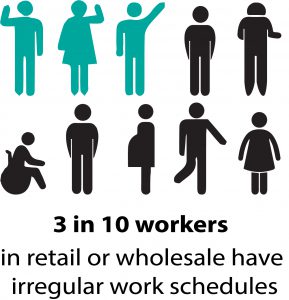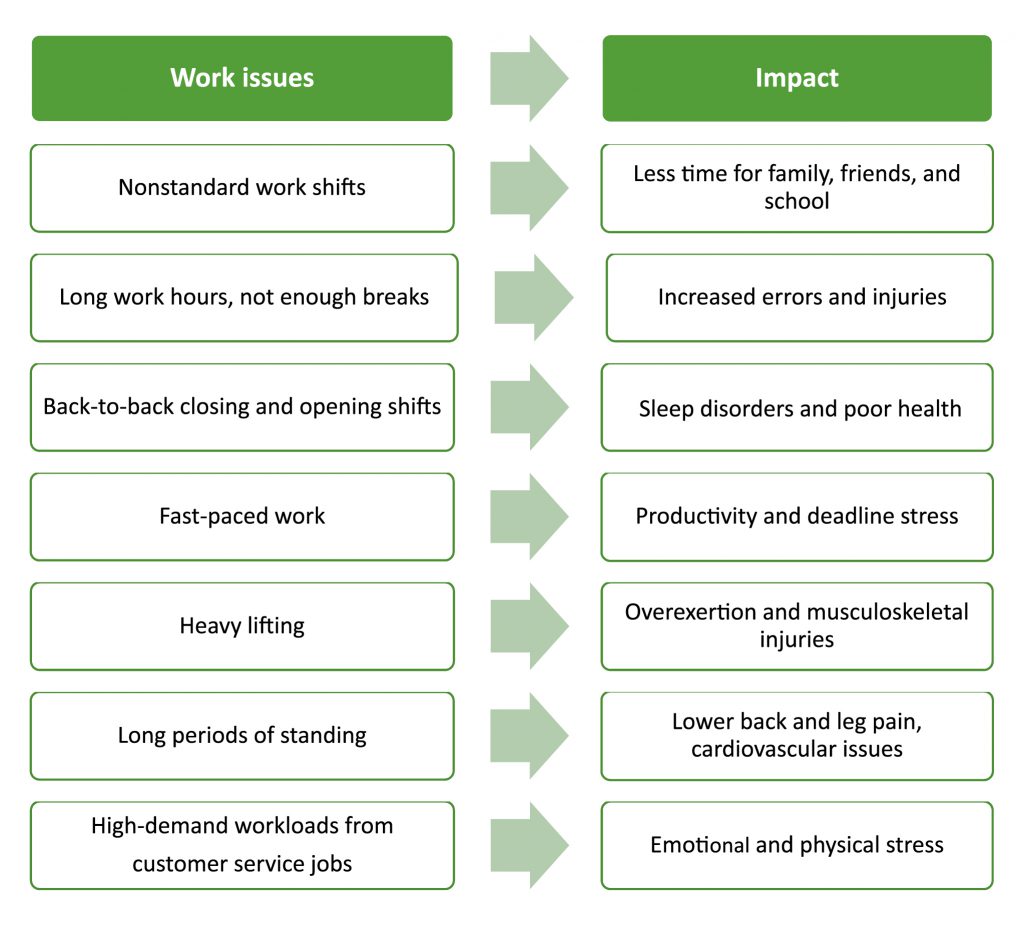Reducing Fatigue and Stress in the Retail Industry: Workplace solutions
Posted on by Workplace fatigue and stress is a growing topic for worker safety and health research. For instance, workplace studies have shown that the nature of retail industry work may cause fatigue and stress. Nonstandard work schedules such as irregular and extended shifts, long periods of standing, and reduced staffing are a few reasons for health issues related to job fatigue and stress [Anderson and Chun 2014; Greenhouse 2015; ACOEM 2012; Katz and Krueger 2016; NIOSH 2019]. Surveys and studies have shown the following:
Workplace fatigue and stress is a growing topic for worker safety and health research. For instance, workplace studies have shown that the nature of retail industry work may cause fatigue and stress. Nonstandard work schedules such as irregular and extended shifts, long periods of standing, and reduced staffing are a few reasons for health issues related to job fatigue and stress [Anderson and Chun 2014; Greenhouse 2015; ACOEM 2012; Katz and Krueger 2016; NIOSH 2019]. Surveys and studies have shown the following:
- More than half of retail workers (particularly food and beverage workers) have nonstandard shifts or workweeks longer than 48 hours [NIOSH 2015a].
- Forty-two percent of retail store and other workers feel that their jobs negatively affect their stress levels [Harvard 2016].
- A recent survey of working adults showed that almost 3 in 10 workers in the retail or wholesale trade have irregular work schedules [Lambert et al. 2014].
In order to better understand these findings, let’s talk about fatigue and its effect on retail workers.
What is fatigue?

Fatigue is the body’s first response to insufficient sleep, a disturbed sleep cycle, an overly demanding physical or mental workload, or an insufficient period of recovery from work. Sleep insufficiency, whether due to a medical disorder or due to lifestyle choices, poses cognitive risks in performing everyday tasks such as driving and operating machinery [Goel et al. 2009]. Common work-related causes of fatigue are long work hours, shift work, environmental factors such as temperature extremes, and heavy workloads [ACOEM 2012; Techera et al. 2016]. People can also feel fatigue when they are fighting off illness, have a chronic disease, experience high levels of stress, and/or take certain medications.
Why does fatigue occur in retail work?
Retail workers have nonstandard work shifts with longer hours of operation. Competition from online retailers has led to reductions in staff, which may require the remaining retail workers to carry additional workloads. Periods of economic decline have led to high unemployment rates and inflation, which may contribute to worker fatigue via physical, financial, or mental stress. Many people stay awake for periods of 16 hours or more for obligations, such as work, family, or social life [Williamson et al. 2000]. After 16-plus hours of being awake, fatigue reaches a level that can compromise safe performance. We also know from sleep research that moderate levels of fatigue can create higher levels of impairment and thus diminish performance more than alcohol intoxication [Drew, Reid 1997]. In light of these risks, employers may want to consider why retail workers are willing to work nonstandard or irregular schedules, take on extra shifts, or accept additional workload. Workers may need the flexibility of retail work schedules for reasons related to education, caregiving [Techera et al. 2016; Greenhouse 2015], or finances.
Now, let’s look at work issues related to retail workplace fatigue and how they may affect retail workers.

Does NIOSH have retail workplace solutions?
Yes! NIOSH researchers have developed strategies for both employers and workers in retail. Consider the following checklists to reduce fatigue and stress in the workplace.
Workers
- Make sure you give yourself enough time to sleep after working your shift.
- Avoid heavy foods and alcohol before sleeping; these can disrupt sleep.
- Get seven or more hours of sleep to feel refreshed and alert the next day.
- Sleep somewhere dark, comfortable, quiet, and cool, so you can fall asleep quickly and stay asleep.
- Ask your doctor for help if you are having trouble sleeping.
- Drink enough water to replace fluids lost from heat and workload; do not wait until you feel thirsty.
- Exercise routinely. Keeping fit can help you manage stress, stay healthy, and improve your sleep.
- Follow current nutrition guidelines on healthful meals and snacks.
- Report injuries and near misses to help determine whether fatigue is an issue.
Employers
- Consider allowing at least 10 hours between shifts, so workers can get 7–8 hours of sleep.
- Consider allowing for variation in workers’ tasks, duties, and positions to avoid monotony and muscle fatigue.
- Give as much advance notice as possible for schedule changes.
- Ensure that 12-hour shifts do not include excessive workloads.
- Consider allowing rest breaks of 10 to 15 minutes regularly, such as every 1–2 hours during demanding work.
- Consider providing anti-fatigue mats, shoe inserts, and sit/stand stations for cashiers and others who stand for long periods.
- Record injuries, near misses, and other information to help determine whether fatigue is an issue.
Employers, workers, their families, and communities all benefit from improved health, illness prevention, and work productivity that can result from adequate amounts of sleep and reduced fatigue [NORA Sector Council 2016].
True well-being requires that workplaces adopt an inclusive approach to worker health and safety [Schulte et al. 2015]. The NIOSH Total Worker Health® (TWH) approach prioritizes work policies, programs, and practices designed to protect workers and improve their health [NIOSH 2015b]. The benefits of a TWH approach can be direct, such as lowering costs to employers paying for worker health–related expenditures, workers’ compensation, and other expenses. Indirect savings, which are harder to measure, include fewer reported illnesses and injuries; lower costs for workers who pay for their own health care expenses; better worker morale; increased productivity with lower worker health risks and fewer medical conditions; improved recruitment and retention; and an increased financial “bottom line” for the business [Fabius et al. 2013; Davis et al. 2005].
In the comment area below, tell us how you handle retail workplace stress and fatigue.
Donna Pfirman is NIOSH Wholesale and Retail Trade Program Co-assistant Coordinator and a Program Analyst in the NIOSH Division of Science Integration.
Seleen Collins is a Technical Writer-Editor in the NIOSH Division of Science Integration.
Special thanks to Claire Caruso, Casey L. Chosewood, Naomi Swanson, Tom Cunningham, Sarah Unthank, and T.J. Lentz for review.
For More Information
NIOSH Wholesale and Retail Trade
References
ACOEM Presidential Task Force on Fatigue Risk Management [2012]. Fatigue risk management in the workplace. ACOEM guidance statement. J Occup Environ Med 54(2):231–258, DOI: 10.1097/JOM.0b013e318247a3b0, https://acoem.org/acoem/media/News-Library/Fatigue-Risk-Management-in-the-Workplace.pdf.
Anderson V, Chun H [2014]. Workplace hazards and prevention options from a nonrandom sample of retail trade businesses. Int J Occup Safety Ergonomics 20(1):181–195, DOI: 10.1080/10803548.2014.11077036.
Caruso C [2014]. Negative impact of shift work and long work hours. Rehabil Nurs 39(1):16–25, DOI: 10.1002/rnj.107.
Davis K, Collins SR, Doty MM, Ho A, Holmgren AL [2005]. Health and productivity among U.S. workers. Washington, DC, Commonwealth Fund Issue Brief, August, Publ. no. 856.
Dawson D, Reid K [1997]. Fatigue, alcohol and performance impairment. Nature 388:235, https://www.nature.com/articles/40775.
Fabius R, Thayer R, Dixon BA, Konicki DL, Yarborough CM, Peterson KW, Isaac F, Loeppke RR, Eisenberg BS, Dreger M [2013]. The link between workforce health, safety, and the health of the bottom line: tracking market performance of companies that nurture a “culture of health.” J Occup Environ Med 55(9):993–1000, DOI: 10.1097/JOM.0b013e3182a6bb75.
Goel N, Rao H, Durmer JS, Dinges DF [2009]. Neurocognitive consequences of sleep deprivation. Semin Neurol 29:320–339, https://www.thieme-connect.com/products/ejournals/html/10.1055/s-0029-1237117.
Greenhouse S [2015]. In service sector, no rest for the working. New York Times, February 22, https://www.nytimes.com/2015/02/22/business/late-to-bed-early-to-rise-and-working-tired.html?_r=0.
Harvard School of Public Health [2016]. The workplace and health. NPR/Robert Wood Johnson Foundation/Harvard School of Public Health, http://www.rwjf.org/content/dam/farm/reports/surveys_and_polls/2016/rwjf430330.
Katz LF, Krueger AB [2016]. The rise and nature of alternative work arrangements in the United States, 1995-2015. Harvard University and NBER; Princeton University and NBER, https://krueger.princeton.edu/sites/default/files/akrueger/files/katz_krueger_cws_-_march_29_20165.pdf.
Lambert SJ, Fugiel PJ, Henly HR [2014]. Schedule unpredictability among early career workers in the US labor market: a national snapshot (executive summary). University of Chicago, https://www.ssa.uchicago.edu/sites/default/files/uploads/lambert.fugiel.henly_.executive_summary.b_0.pdf.
NIOSH [1997]. Plain language about shift work. By Rosa RR, Colligan MJ. Cincinnati, OH: U.S. Department of Health and Human Services, Centers for Disease Control and Prevention, National Institute for Occupational Safety and Health, DHHS (NIOSH) Publication No. 97-141, https://www.cdc.gov/niosh/docs/97-145/pdfs/97-145.pdf.
NIOSH [2015a]. National health interview survey: occupational health supplement. Cincinnati, OH: U.S. Department of Health and Human Services, Centers for Disease Control and Prevention, National Institute for Occupational Safety and Health, https://www.cdc.gov/niosh/topics/nhis.
NIOSH [2015b]. NIOSH workplace safety and health topic: total worker health. Cincinnati, OH: U.S. Department of Health and Human Services, Centers for Disease Control and Prevention, National Institute for Occupational Safety and Health, https://www.cdc.gov/niosh/twh/totalhealth.html.
NIOSH [2015c]. NIOSH training for nurses on shift work and long work hours. By Caruso CC, Geiger-Brown J, Takahashi M, Trinkoff A, Nakata A. Cincinnati, OH: U.S. Department of Health and Human Services, Centers for Disease Control and Prevention, National Institute for Occupational Safety and Health, DHHS (NIOSH) Publication No. 2015-115, https://www.cdc.gov/niosh/docs/2015-115/default.html.
NIOSH [2017]. Using Total Worker Health® concepts to reduce the health risks from sedentary work. Cincinnati, OH: U.S. Department of Health and Human Services, Centers for Disease Control and Prevention, National Institute for Occupational Safety and Health, DHHS (NIOSH) Publication No. 2017-131, https://www.cdc.gov/niosh/docs/wp-solutions/2017-131.
NORA WRT Sector Council [2016]. Sleep deficiency, fatigue, pain, and loss of productivity in retail work. National Occupational Research Agenda, Sector Council Bulletin: Wholesale and Retail Trade. Issue 7, July, https://www.cdc.gov/niosh/programs/wrt/pdfs/wrt-sector-council-bulletinw3-2016-07-20.pdf.
Schulte PA, Wagner GW, Ostry A, Blanciforti LA, Cutlip RG, Krajnak KM, Luster M, Munson AE, O’Callaghan JP, Parks CG, Simeonova PP, Miller DB [2007]. Work, obesity, and occupational safety and health. Am J Public Health 97(3):428–436, http://www.ncbi.nlm.nih.gov/pmc/articles/ PMC1805035.
Schulte PA, Schill AL, Guerin RJ, Bhattacharya A, Cunningham TR, Pandalai SP, Eggerth D, Stephenson CM [2015]. Considerations for incorporating “well-being” in public policy for workers and workplaces. Am J Public Health 105(8):e31–e44, https://www.ncbi.nlm.nih.gov/pmc/articles/PMC4504308/.
Sorenson G, McLellan D, Dennerlein JT, Pronk NP, Allen JD, Boden LI, Okechukwu CA, Hashimoto D, Stoddard A, Wagner GR [2013]. Integration of health protection and health promotion: rationale, indicators, and metrics. J Occup Med 55(120)S12–S18, http://www.ncbi.nlm.nih.gov/ pmc/articles/PMC4184212/.
Techera U, Hallowell M, Stambaugh N, Littlejohn R [2016]. Cases and consequences of occupational fatigue: meta-analysis and systems model. J Occup Environ Med August, https://www.ncbi.nlm.nih.gov/pubmed/27525527.
Williamson AM, Feyer AM [2000]. Moderate sleep deprivation produces impairments in cognitive and motor performance equivalent to legally prescribed levels of alcohol intoxication. Occup Environ Med 57:649–655, https://oem.bmj.com/content/oemed/57/10/649.full.pdf.
Posted on by

